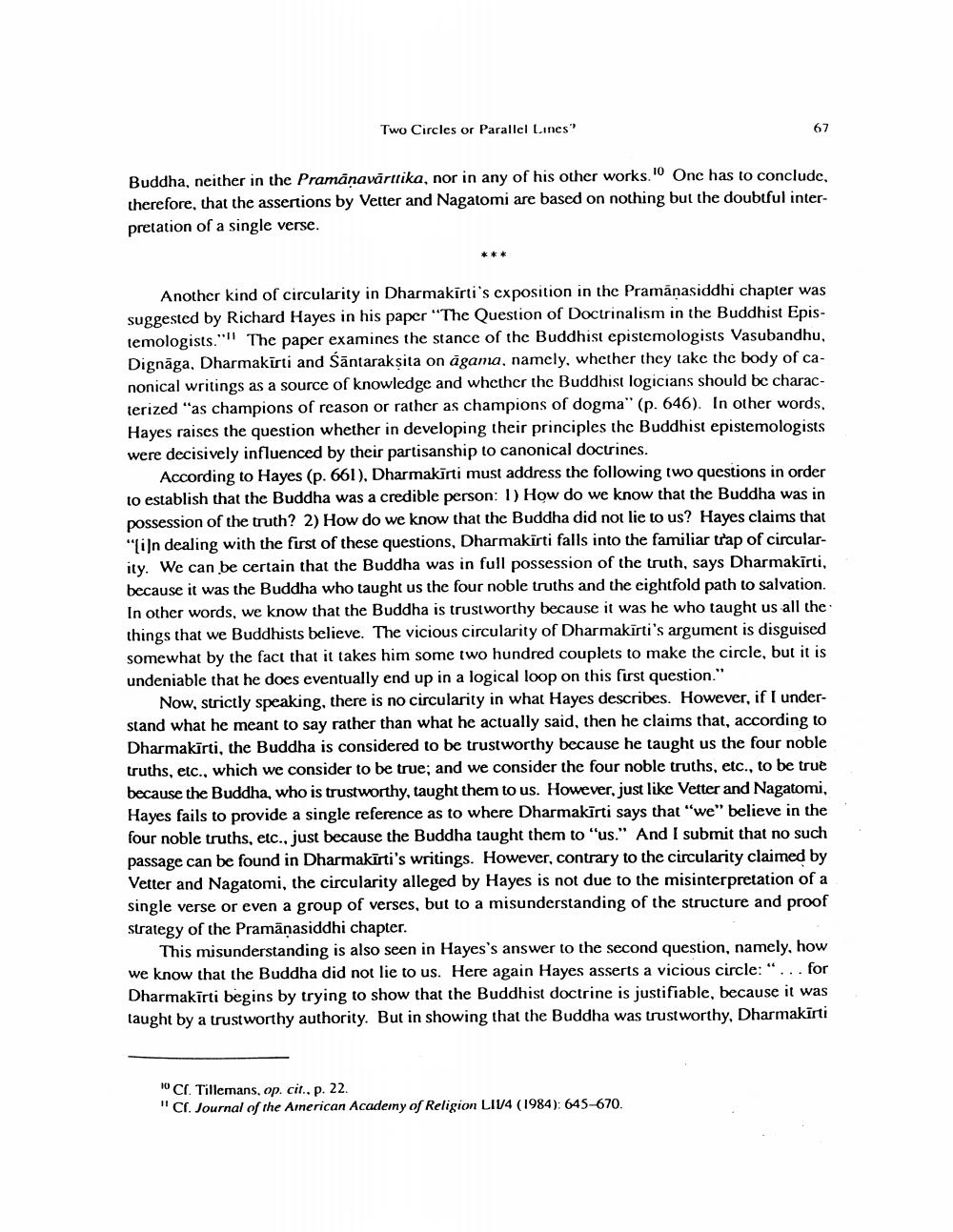Book Title: Two Circles Or Parallel Lines Author(s): Eli Franco Publisher: Eli Franco View full book textPage 5
________________ Two Circles or Parallel Lines 67 Buddha, neither in the Pramanavārtika, nor in any of his other works. Onc has to conclude, therefore, that the assertions by Vetter and Nagatomi are based on nothing but the doubtful interpretation of a single verse. * * * Another kind of circularity in Dharmakirti's exposition in the Pramānasiddhi chapter was suggested by Richard Hayes in his paper "The Question of Doctrinalism in the Buddhist Epistemologists." The paper examines the stance of the Buddhist epistemologists Vasubandhu, Dignāga, Dharmakirti and sāntaraksita on agama, namely, whether they take the body of canonical writings as a source of knowledge and whether the Buddhist logicians should be characterized "as champions of reason or rather as champions of dogma" (p. 646). In other words, Hayes raises the question whether in developing their principles the Buddhist epistemologists were decisively influenced by their partisanship to canonical doctrines. According to Hayes (p. 661), Dharmakirti must address the following two questions in order to establish that the Buddha was a credible person: 1) How do we know that the Buddha was in possession of the truth? 2) How do we know that the Buddha did not lie to us? Hayes claims that "[i]n dealing with the first of these questions, Dharmakirti falls into the familiar trap of circularity. We can be certain that the Buddha was in full possession of the truth, says Dharmakirti, because it was the Buddha who taught us the four noble truths and the eightfold path to salvation. In other words, we know that the Buddha is trustworthy because it was he who taught us all the things that we Buddhists believe. The vicious circularity of Dharmakirti's argument is disguised somewhat by the fact that it takes him some two hundred couplets to make the circle, but it is undeniable that he does eventually end up in a logical loop on this first question." Now, strictly speaking, there is no circularity in what Hayes describes. However, if I understand what he meant to say rather than what he actually said, then he claims that, according to Dharmakirti, the Buddha is considered to be trustworthy because he taught us the four noble truths, etc., which we consider to be true; and we consider the four noble truths, etc., to be true because the Buddha, who is trustworthy, taught them to us. However, just like Vetter and Nagatomi, Hayes fails to provide a single reference as to where Dharmakirti says that "we" believe in the four noble truths, etc., just because the Buddha taught them to "us." And I submit that no such passage can be found in Dharmakārti's writings. However, contrary to the circularity claimed by Vetter and Nagatomi, the circularity alleged by Hayes is not due to the misinterpretation of a single verse or even a group of verses, but to a misunderstanding of the structure and proof strategy of the Pramānasiddhi chapter. This misunderstanding is also seen in Hayes's answer to the second question, namely, how we know that the Buddha did not lie to us. Here again Hayes asserts a vicious circle: "...for Dharmakirti begins by trying to show that the Buddhist doctrine is justifiable, because it was taught by a trustworthy authority. But in showing that the Buddha was trustworthy, Dharmakirti 1° C. Tillemans, op. cit., p. 22. "Cf. Journal of the American Academy of Religion LIV4 (1984): 645-670.Page Navigation
1 ... 3 4 5 6 7 8 9 10
